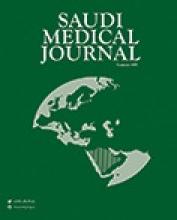Abstract
OBJECTIVE: To identify factors that contributed to morbidity and mortality of cystic fibrosis (CF) population in the Kingdom of Saudi Arabia (KSA).
METHODS: This retrospective chart review was carried out in King Faisal Specialist Hospital and Research Centre, Riyadh, KSA, during a 9 year period, November 1993 to November 2002, on confirmed CF patients, for demographic, clinical and mortality data.
RESULTS: A total of 190 CF patients were diagnosed during the 9 years. One hundred and sixty-four (86%) patients are alive, 26 (14%) died. Ninety-nine (52%) were males and 91 (48%) were females. Age at diagnosis 2.8 ± 3.5 years, and period of follow up 3 ± 3 years. In 80% of patients, symptoms started <1 year of age. Sixty-five percent of patients were in the mild to moderate malnutrition stage (<90th percentile), and 63% are in the mild to moderate stunted growth (<90th percentile). Factors that contributed to early mortality are: calculated weight/height (p-value 0.01), low albumin level at follow up (0.001), high hematocrit (HCT) (p-values=0.0002), low mean corpuscular volume (MCV) (p-0.0002), low mean corpuscular hemoglobin concentration (MCHC) (p-value 0.001), early development of antibiotic resistance (p-value=< 0.01).
CONCLUSION: High HCT, low MCV, low MCHC and low albumin are factors related to poor prognosis and early death in CF patients. Iron supplement should be given to these patients even in the presence of normal hemoglobin. Early nutritional rehabilitation is needed to improve survival of our CF patients. Cohort isolation should be encouraged in CF centres. Early treatment of chronic pseudo colonization should be adopted to improve survival.
- Copyright: © Saudi Medical Journal
This is an open-access article distributed under the terms of the Creative Commons Attribution-Noncommercial-Share Alike 3.0 Unported, which permits unrestricted use, distribution, and reproduction in any medium, provided the original work is properly cited.






